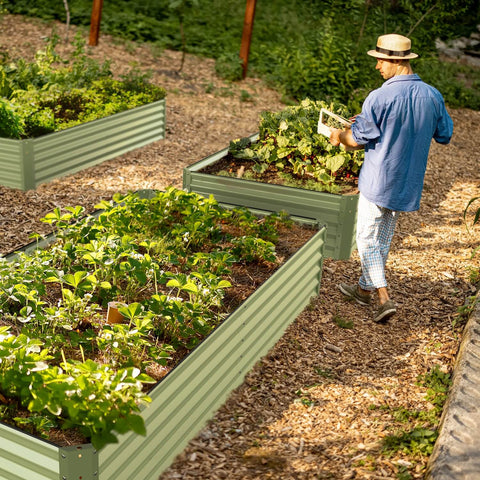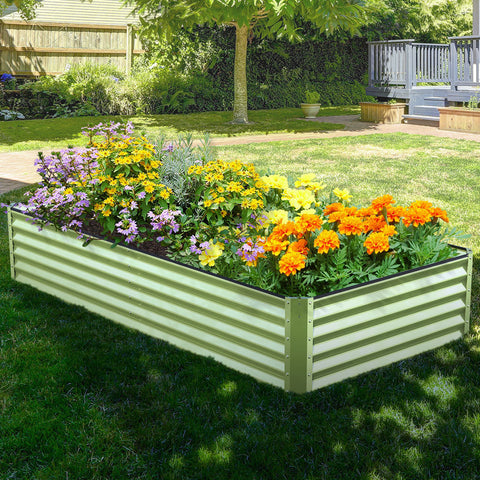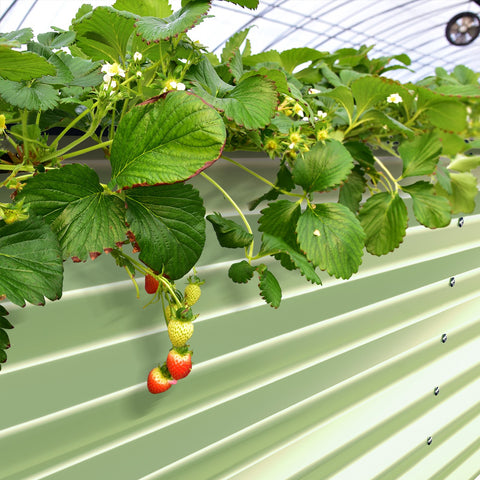Whether you have a green thumb or not, check out this list of basic gardening tips to make sure all your plants are thriving before you get started. The following content also has some reference value for raised garden beds.
When you're just starting out gardening, it may feel like there's a lot to know and you have a thousand questions to ask. How should you grow vegetables, and what kind of soil is best? When should you prune hydrangeas and when should you divide them? Is everything getting enough sun and water? The good news is that nature is an amazing teacher. The more you plant, the more you'll know what works and what doesn't. But for now, use this list of basic gardening tips to find answers to the most common questions beginners ask. Don't forget to have fun growing your own food and beautiful flowers in the yard!
- Learn about USDA Hardiness Zones. With this as a guide, avoid planting trees, shrubs, and perennials that won't winter in your area. You can also get a better idea of when the last frost of spring will be, so you know when you can plant vegetables, fruits, and annuals in your area.
- Don't know when to trim? Spring-flowering shrubs, such as lilacs and large-flowered climbing roses, are pruned immediately after the flowers fade. Their buds came out last fall. If you prune them in the fall or winter, you remove the buds for next spring.
- Apply only compost, rotted fertilizer that has solidified for at least six months. Fresh manure is so high in nitrogen that it can burn plants. It can also contain pathogens or parasites. Pig, dog and cat feces should not be used in gardens or compost piles because they can contain parasites that can infect humans.
- Perennials usually take three years to reach mature size after planting. Remember the proverb: They "sleep, crawl and jump" each year.
- Know how long your growing season is (the time between the last frost of spring and the first frost of fall) so you can grow some plants indoors, or avoid them.
- Dead heads are a good practice for perennials and annuals. Because the goal of annuals is to bloom, set seeds, and die, when you remove old flowers, it tells annuals to produce more flowers. Removing flowers also encourages plants to use their energy to grow stronger leaves and roots instead of producing seeds. Avoid headless plants, such as laurel, that are used primarily to decorate fruit or pods.
- Pay close attention to how much light different plants need. Grow vegetables in an area with at least eight hours of direct sunlight a day. Most vegetables need full sunlight for the best harvest. If you have shade, try planting cool-season crops like lettuce, spinach, radishes, and cabbage.
- The best way to control weeds in your garden is to weed and hoe by hand. Avoid deep ploughing or tilling, as this can bring weed seeds to the surface of the soil and cause them to germinate. Weed early and often to prevent weeds from going to seed. Use mulch to suppress and prevent annual weeds.
- Hostas don't need to be separated unless you want to rejuvenate an old plant, or increase your number, or simply prefer the look of a single plant. The best time to divide hostas is in the spring before new shoots appear and leaves unfold, or at least four weeks before the soil freezes in the fall.
-
Not all hydrangeas grow in the shade. Hydrangea paniculata needs sunlight to bloom. Some of the top spike-type varieties include "Limelight", "Little Lime", "Vanilla Strawberry", and "Bombshell".

- Don't clean out your garden in the fall. Leave ornamental grasses to beautify and perennials with seed heads to feed the birds, such as conical flowers. Avoid cutting down perennials that are barely hardy, such as garden mums, to increase their chances of surviving the harsh winter.
- Vegetable gardening tip: The best temperature for tomatoes to ripen is between 68 and 77 degrees Fahrenheit. At 85 degrees Fahrenheit, plants can't produce lycopene and carotene, the pigments responsible for fruit color. Green fruit will not ripen once the temperature is consistently below 50 degrees Fahrenheit. Tomatoes with a little color change can be brought in to finish ripening.
- Plant spring-flowering bulbs such as tulips, fritillaria, ornamental alliums and crocus before the ground freezes in the fall. In general, place the bulb in a hole two to three times as deep as the bulb. Most hardy bulbs you only need to plant once and they'll grow year after year, but hybrid tulips are an exception. It's best to pull them out when the bloom is over and replant new tulip bulbs every fall, or opt for perennial tulips.
-
Dead heads are found on bulbs that bloom in the spring, like daffodils and hyacinths, so these plants transfer energy to the bulb instead of producing seeds. Leave the leaf there until it turns brown and can be removed with a gentle tug. The leaves store the nutrients needed for the bulb to blossom the following year. Braiding or tying the leaves is not recommended, as this reduces the amount of light reaching the surface.

- Fertilizer is not the answer to growing the best plants; The soil quality is. Add organic amendments, such as compost and aged fertilizer, to the soil. The best soil structure is fragile, easy to dig, receptive to water, and loose enough to provide oxygen to plant roots. If you use fertilizer, use organic fertilizer to add nitrogen, phosphate, and potassium (the form of potassium that plants can use).
- Late summer or early autumn is the best time to divide and transplant spring flowering perennials. The most common perennials are irises, peonies, hostas and daylilies.
- If your rhubarb grows flower stems, remove them so it can focus on growing leaves, not seeds.
- When transplanting container-grown perennials, dig a hole twice as wide as the plant's soil ball to help root establish. Make sure the plant is as deep in the hole as it is in the container. Use excavated soil to fill new plants instead of bagging soil.
- Pile your potatoes deep in the soil and store the harvested potatoes in complete darkness. The skin turns green when exposed to light, indicating that potatoes produce a colorless alkaloid called solanine, a bitter toxin that can cause illness if consumed in large amounts. Cut off any green parts or sprouts on the potatoes to avoid this problem.
-
Most underground garden plants grow best under 1 to 2 inches of water per week. If there isn't enough rain, water deeply once a week instead of lightly every day. Frequent shallow water only moistens the top layer of soil and encourages plant roots to move there instead of growing deeper.

- Don't send your fallen leaves away! Instead, chop them up and use them as compost. The crushed leaves can be used to nourish the lawn. After a few hard freezes, when the plants are completely dormant, you can also use 3-6 inches of crushed leaves as mulch over soft perennials to keep them that way through the winter. Remove mulch in the spring.
- Avoid digging or planting in wet soil; Mining can damage the soil structure. When the soil is so crumbly that it no longer forms a ball, you can squeeze some into your hand (it doesn't have to be very dry) to till or dig.
- Know about soil drainage. Roots need oxygen, and if the soil is wet all the time, roots don't have the air they need to grow. Many plants prefer well-drained soil, so use organic materials to improve soil quality.
- Some plants bloom according to the length of day. Mums, poinsettias, strawberries and other plants need long nights to bloom. If you want strawberries that bloom and bear fruit at temperatures between 35°F and 85°F, choose varieties labeled "neutral during the day."
- Native plants are often better adapted to growing in your area than plants in other parts of the world. They're also better for the local pollinators that evolved with them. If you want to grow plants to support pollinators, don't plant new varieties of double flowers, as all the extra petals will make it harder for insects to reach the nectar and pollen.









